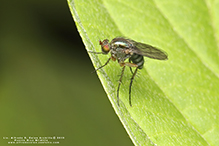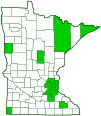longlegged flies
(Dolichopus spp.)
Overview • Description • Distribution • Taxonomy
Description |
Adults are small, mostly less than 5⁄16″ (8 mm) in length. Almost all species are bright metallic green and blue. The antennae have three segments and a long bristle (arista) at the base of the third segment. The elongated mouthparts (palps) have just one segment. On the male the genitalia are large, conspicuous, and folded under the abdomen. The last part of the leg (tarsus), corresponding to the foot, has five segments. On the male, the last tarsal segment on the front leg is flattened, flag-like. The last tarsal segment on the hind leg has several spines in the upper side. This feature separates the genus Dolichopus from all other fly genera in North America. On the wing, the radial sector (Rs) vein has two branches and is slightly swollen at the fork. The radial-media (r-m) cross vein, a short vein between the radius and media veins, is in the basal quarter of the wing. The basal cells are very small. The larvae are maggot-like. |
Distribution |
||
|
Sources Van Duzee, M. C., Frank R. Cole, and John M. Aldrich. 1921. The dipterous genus Dolichopus in North America. Bull. U.S. Natn. Mus 116. |
|
| 8/29/2024 | ||
Taxonomy |
|||||
Order |
|||||
Suborder |
Brachycera |
||||
Infraorder |
Orthorrhapha |
||||
Superfamily |
Empidoidea (dance flies, long-legged flies, and allies) |
||||
Family |
Dolichopodidae (long-legged flies) |
||||
Subfamily |
Dolichopodinae |
||||
Tribe |
Dolichopodini |
||||
Subordinate Taxa |
|||||
|
|||||
Synonyms |
|||||
|
|||||
Common Names |
|||||
This genus has no common name. The common name for the family Dolichopodidae is long-legged flies, and it is applied here for convenience. |
|||||
Glossary
Arista
A large bristle on the upper side of the third segment of the antenna of a fly. Plural: aristae.
Palp
Short for pedipalp. A segmented, finger-like process of an arthropod; one is attached to each maxilla and two are attached to the labium. They function as sense organs in spiders and insects, and as weapons in scorpions. Plural: palpi or palps.
Tarsus
On insects, the last two to five subdivisions of the leg, attached to the tibia; the foot. On spiders, the last segment of the leg. Plural: tarsi.
Visitor Photos |
||
Share your photo of this insect. |
||
This button not working for you? |
||
Alfredo Colon |
||
 |
||
 |
 |
|
 |
 |
|
 |
 |
|
MinnesotaSeasons.com Photos |
||
|
||
|
||

Slideshows |
|

Visitor Videos |
||
Share your video of this insect. |
||
This button not working for you? |
||
|
Other Videos |
||
LONGLEGGED FLY, Dolichopus about to reproduce |
About
Feb 29, 2020 LONGLEGGED FLY, Dolichopus about to reproduce. Grainy because of the deep shade it was in. took off before dropping the larva. |
Long-legged Fly (Dolichopodidae: Dolichopus) Missing Two legs |
About
Jun 22, 2010 Photographed at Grand Forks, North Dakota (21 June 2010). |
Long-legged Fly (Dolichopodidae: Dolichopus) Feeding |
About
Jun 20, 2010 Photographed at Grand Forks, North Dakota (19 June 2010). |

Visitor Sightings |
||
Report a sighting of this insect. |
||
This button not working for you? |
||
Alfredo Colon |
Location: Albany, NY |
 |
| Alfredo Colon 6/12/2024 |
Location: Albany, NY |
 |
Alfredo Colon |
Location: Albany, NY |
 |
| Alfredo Colon 8/6/2022 |
Location: Albany, NY |
 |
| Alfredo Colon 8/8/2019 |
Location: Woodbury, MN |
 |
MinnesotaSeasons.com Sightings |
||
|

Created: 1/22/2021 Last Updated: © MinnesotaSeasons.com. All rights reserved. |
